| |
|
|
Season And Varieties
District/Season |
|
Varieties/Hybrids |
Irrigated (Main)
Winter Irrigated (Aug – Sep) |
|
|
Coimbatore, Erode, Madurai, Dindigul, Theni |
: |
MCU 5, MCU 5 VT, Suvin, TCHB 213*, MCU 12, MCU 13, Surabhi, Sumangala, Sruthi* |
Dharmapuri |
: |
MCU 5, TCHB 213*, MCU 12, MCU 13, Suvin |
Salem, Namakkal |
: |
MCU 5, Suvin, TCHB 213*, MCU 12, MCU 13, Sumangala |
Cuddalore, Villupuram |
: |
MCU 5, MCU 12, MCU 13, LRA 5166, TCHB 213*, SVPR 2, Surabhi, |
Summer – Irrigated (Feb – Mar) |
|
|
Erode |
: |
MCU 5, MCU 5 VT, SVPR 2 , Supriya, MCU 12, MCU 13, TCHB 213 |
Madurai, Dindigul, Theni |
: |
MCU 5, MCU 5 VT, MCU 12,MCU 13, SVPR 2, Supriya, |
Ramanathapuram, Virudhunagar, Sivagangai, Tirunelveli, Thoothukudi |
: |
MCU 5, MCU 5 VT, SVPR 2, MCU 12, MCU 13 |
Rainfed (Sep – Oct) |
|
|
Madurai, Dindigul, Theni |
: |
LRA 5166, K11, KC 2, SVPR 2 |
Ramanathapuram, Virudhunagar, Sivagangai |
: |
LRA 5166, K 11, KC 2, SVPR 2 |
Tirunelveli, Thoothukudi, Dharmapuri |
: |
LRA 5166, K 11, KC 2, SVPR 2 |
Rice Fallow |
|
|
Thanjavur, Tiruvarur, Nagapattinam, Parts of Trichirapalli, Perambalur, Karur, Cuddalore and Villupuram |
: |
MCU 7, SVPR 3, Anjali |
* Hybrid
Particulars of Cotton Varieties/Hybrids
Varieties/ Hybrids |
Parentage |
Season |
Irrigated/ Rainfed |
Mean yield of seed (kg/ha) |
Special features |
MCU 5 |
Multiple cross |
Aug-Oct
Feb-Mar |
Irrigated |
1850 |
Extra long staple (29 mm MHL),
Can spun upto 70s, ginning 34% |
MCU 7 |
X ray irradiation of X L 1143 EE |
Jan-Feb |
Rice fallows |
1330 |
Medium staple (23.7 mm MHL), Can spun upto 30s, early maturing with 33.2% ginning outturn. Tolerant to Black arm |
MCU 12 |
Derivative from the cross LRA 5166 x MCU 11 |
Aug-Oct |
Irrigated |
2000 |
Shorter in duration than MCU 5, GOT 34.8%
Can spun upto 50s |
MCU 13 |
It is a multiple cross derivative involving the parents of [(TCH 665 x LS 149) x (TCH 665 x TCH 21)] x (TCH 21 x EECH) x (TCH 92-7 x EECH) |
Aug- Oct Jan-Feb |
Irrigated |
2200 |
Early duration
Can spun upto 50s |
LRA 5166 |
Laxmi x Reba B.50 x AC 122 |
Aug-Oct Jan –Feb |
Irrigated Rainfed |
1800
725 |
Medium staple (29 mm), Can spun upto 40s, ginning 36.2% |
MCU 5 VT |
Reselection from MCU 5 |
Aug-Oct Jan –Feb |
Irrigated |
2000 |
Extra long staple, Verticillium wilt tolerant |
Supriya |
MCU 5 x C 1998 |
Aug-Oct Jan-Feb |
Irrigated |
2000 |
White fly tolerant |
Anjali |
LRA 5166 x (Khandwa 2 x Reba B 50) BC 2 |
Jan –Feb |
Irrigated
(Rice fallows) |
1800 |
Dwarf, semi compact plant type |
Surabhi |
MCU 5 VT
(MCU 5 x G.mexicanum) |
Aug-Oct |
Irrigated |
2200 |
Exta long staple, Verticillium wilt resistant |
Sumangala |
CW 134 x Reba B 50 x Khandwa 2 |
Sept-Oct Jan –Feb |
Irrigated
Rainfed |
2000
1200 |
Suitable for rainfed tract |
Sruthi |
70 E x RSP 4 |
Sept-Oct Jan –Feb |
Irrigated |
2500 |
Early duration |
K 11 |
(0794-1-DX H 876) x (0794-1-DX H 450) Multiple Hybrid derivative |
Sept – Oct |
Rainfed |
1100 |
Better fibre properties with lesser pest incidence than K10 |
Suvin |
Hybrid derivative from the cross Sujatha x St. Vincent |
Aug-Oct |
Irrigated |
1020 |
Extra long staple cotton with 28% ginning outturn and 32 mm MHL, spins 100s |
Particulars of Cotton Varieties/Hybrids
Varieties/ Hybrids |
Parentage |
Season |
Irrigated/ Rainfed |
Mean yield of seed (kg/ha) |
Special features |
TCHB 213 |
Interspecific Hybrid of TCH 1218 (G.hirsutum)
and TCB 209 (G.barbadense) |
Aug-Sep |
Irrigated |
2215 |
High yielding, early maturing, Tolerant to leaf spot diseases |
SVPR 2 |
TSDT 22 x JR 36 |
Feb - Mar
Sep-Oct |
Irrigated
Rainfed |
2000 |
High ginning out turn of 36.4%, medium staple (24.3 mm), can spin 30's, suited to summer irrigated, winter rainfed and tankfed rice fallow tracts of Tamil Nadu. |
SVPR 3 |
Selection from L.H 900 x 1301 D.D |
Jan-Feb |
Rice fallows |
1800 |
Suitable for rice fallow tract.
early duration (135-140 days). Tolerant to drought,
leafhopper, alternaria spot, black arm disease. |
KC 2 |
MCU 10 x KC 1 |
Sep - Oct |
Rainfed |
1000 |
High ginning out turn of 37.5%, medium staple cotton - 24.4 mm, Suited for rainfed black cotton soil of Tirunelveli, Thoothukudi and Virudhunagar Districts. |
Preparation of Field for Irrigated Cotton Crop
1. PREPARATION OF THE FIELD
i) |
Prepare the field to get a fine tilth. |
ii) |
Chiselling for soils with hard pan: Chisel the soils having hard pan formation at shallow depths with chisel plough at 0.5 M interval, first in one direction and then in the direction perpendicular to the previous one, once in three years. Apply 12.5 t farm yard manure or composted coir pith/ha besides chiselling to get increased yield |
iii) |
If intercropping of Greengram/Soybean is proposed, prepare the main field, so as to provide ridges and furrows to take up sowing 20 days prior to cotton sowing. |
2. APPLICATION OF FYM OR COMPOST
Spread 12.5 t of FYM or compost or 2.5 t of vermicompost per ha if available, uniformly on the unploughed soil.
3. APPLICATION OF BIOFERTILIZER
Seed treatment with 3 packets of Azospirillum (600 g/ha) and 3 packets (600 g/ha) of Phosphobacteria or 6 packets of Azophos(1200 g/ha). In addition apply 10 packets of Azospirillum (2000 g/ha) and 10 packets (2000 g/ha) of Phosphobacteria or 20 packets of Azophos (4000 g/ha) mixed with 25 kg FYM and 25 kg of soil on the seed line. This saves 25% nitrogen besides increasing yield.
4. FORMATION OF RIDGES AND FURROWS
i) |
Form ridges and furrows 10 m long with appropriate spacing depending upon the variety. |
ii) |
Use ridge plough or bund former to form ridges so as to economise on cost of cultivation. |
iii) |
In fields with ragi stubbles, just dibble cotton seeds at the specified spacings. |
v) |
Adopt the following spacing between ridges for different varieties/hybrids. |
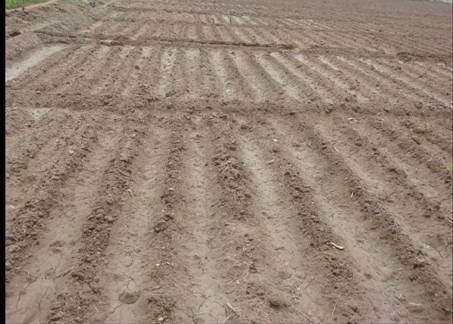
Form ridges and furrows 10 m long with appropriate spacing
Varieties/Hybrids Spacing between ridges (cm)
MCU 5, SVPR 2, LRA 5166, MCU 12, MCU 13 75
TCHB 213 120
Suvin 90
MCU 7 60
NOTE: Adopt higher spacing rows in fertile soils by 15 to 30 cm.
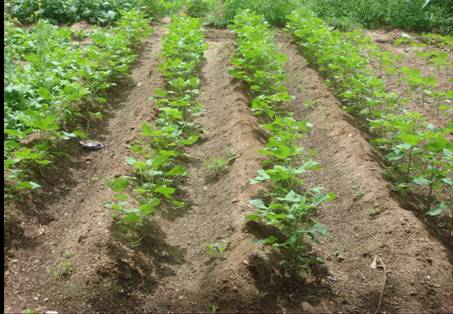
Cotton cultivation in ridges and furrows
5. APPLICATION OF INORGANIC FERTILIZERS
- Apply NPK fertilizers as per soil test recommendations.
If soil test recommendations are not available, follow the blanket recommendation for the different varieties.
Varieties / Hybrids |
Quantity of fertilizers (Kg/ha) |
|
N |
P2O5 |
K20 |
MCU 7, SVPR 3 |
60 |
30 |
30 |
MCU 5, MCU 5 VT, MCU 12, MCU 13,Suvin, SVPR 2 |
80 |
40 |
40 |
TCHB 213, |
120 |
60 |
60 |
-
If basal application could not be done, apply on the 25th day after sowing.
-
Apply 50 per cent of N and K full dose of P2O5 as basal and remaining ½ N and K at 40 – 45 DAS for varieties. For hybrids apply N in three splits viz., basal, 45 and 65 DAS.
v) Foliar application of 2% DAP + 1% KCl will improve kapas yield.
vi) Apply the fertilizers in a band, two-thirds of the distance from the top of the ridge, and incorporate.
6. APPLICATION OF MICRONUTRIENT MIXTURE
Mix 12.5 kg of micronutrient mixture formulated by the Department of Agriculture, Tamil Nadu with enough sand to make a total quantity of 50 kg for one ha.
7. NUTRITIONAL DISORDERS’ CORRECTION
- In the case of Zinc deficient soils ZnSO4 @ 50 kg/ha as basal or ZnSO4 0.5% spray thrice at 45, 60 and 75 DAS.
- When reddening occurs in leaves apply 5% MgSO4 Urea (1.0%) and ZnSO4 (0.10%) as foliar spray on 50th and 80th day to correct this malady. In Mg deficient areas apply MgSo4 @ 20 kg/ha basally.
II. MANAGEMENT OF MAIN FIELD OPERATIONS
I. SEED RATE
Adopt the following seed rates for different varieties/hybrids
Varieties / Hybrids |
Quantity of seed (Kg/ha) |
With fuzz |
Delinted |
Naked |
MCU 5, MCU 5 VT, MCU 7, MCU 12, MCU 13 |
15.00 |
7.50 |
.. |
SVPR 2 |
15.00 |
.. |
.. |
KC 2 |
20.00 |
15.00 |
.. |
SUVIN |
.. |
.. |
6.00 |
TCHB 213 |
2.5 |
2.0 |
.. |
2. SPACING
In a pure crop of cotton, adopt the spacing as below for the different varieties.
Varieties / hybrids |
Spacing ( cm) |
Between rows |
Between plants |
MCU 5, MCU 5 VT, MCU 12, MCU 13 |
75 |
30 |
LRA 5166, SVPR 2 |
|
KC 2 |
45 |
15 |
SUVIN |
90 |
45 |
TCHB 213 |
120 |
60 |
MCU 7, SVPR 3 |
60 or 75 * |
30 |
* Fertile soils
- If cotton intercropped with other crops, one paired row of cotton is alternated with three rows of intercrop and the total population of cotton crop is maintained at the same level as in the case of pure crop.
- For intercropping with Greengram / Soybean, complete the sowing and irrigation 20 days prior to cotton sowing on one side of the ridge.
Varieties/hybrid |
Spacing for cotton crop ( cm) |
Within
Paired row |
Between Paired rows |
Between plants |
MCU 5, MCU 5 VT, MCU 12,MCU13 |
60 |
90 |
30 |
SUVIN |
80 |
100 |
45 |
TCHB 213 |
100 |
140 |
60 |
Plant two rows of intercrop between each paired row of cotton
Intercrop |
Seed rate(kg/ha) |
Spacing (cm) |
Rows |
Plants |
Blackgram |
12.5 |
30 |
10 |
Greengram |
12.5 |
30 |
10 |
Cowpea |
7.5 |
30 |
20 |
Soybean |
20.0 |
30 |
10 |
For higher returns, advance sowing of either greengram or soyabean 20 days before sowing of cotton in winter season.
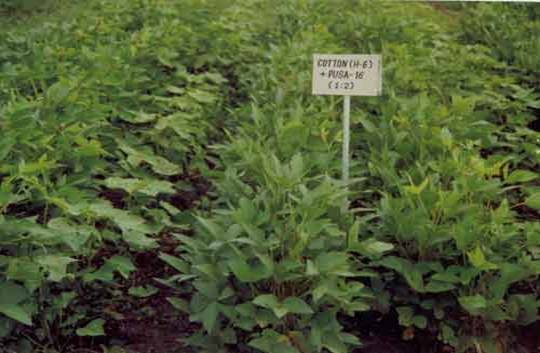
Cotton intercropped with soybean
Source: www.cicr.nic.in

Cotton + Blackgram intercropping

Cotton + greengram intercropping
3. ACID-DELINTING OF COTTON SEEDS
i) |
Choose plastic bucket bucket for acid delinting of seeds. |
ii) |
Do not use earthen wares, metal vessels, porcelain wares or wooden drum for acid delinting as concentrated sulphuric acid will corrode them. |
iii) |
Put the required quantity of seeds in the container and add commercial concentrated sulphuric acid at the rate of 100 ml per kg of fuzzy seed. |
iv) |
Stir vigorously and continuously with a wooden stick for 2 to 3 minutes till the fuzz sticking to the seeds is completely digested and the seed coat attains a dark brown colour of coffee powder. |
v) |
Add water to fill the container. Drain the acid water and repeat the washing 4 or 5 times to remove any trace of acid. |
vi) |
Remove the floating, ill-filled and damaged seeds while retaining the healthy and good seeds which remain at the bottom. |
vii) |
Drain the water completely and dry the delinted seeds in shade. |
NOTE: Acid delinting has the following advantages:
- Eliminates some externally seed borne pathogenic organisms.
- Kills eggs, larvae and pupae of pink boll worm.
- Helps to remove immature, ill-filled, cut and damaged seeds.
- Makes seed dressing more effective and easy
- Facilitates easy sowing and good germination.
4A. PRE-TREATMENT OF ACID DELINTED SEEDS WITH FUNGICIDES
i) Treat the delinted seeds with talc formulation of Trichoderma viride @ 4g/kg of seed or with Carbendazim (or) Thiram @ 2g/kg of seed.
Biocontrol agents are compatible with biofertilizers.
First treat the seeds with biocontrol agents and then with biofertilizers.
Fungicides and biocontrol agents are incompatible.
ii) Treat the delinted fungicide treated seeds with 3 packets (600 g) of Azospirillum and 3 packets of phosphobacteria 600g (or) 6 packets of Azophos (1200 g) and sow immediately.
4B. SEED HARDENING
Soak the seeds in equal volume of Pungam leaf extract (1%) for 8 hours and dry back to original moisture to increase germination and vigour. Dry the seeds in shade.
Seed pelleting: Seeds coated with arappu leaf powder (100 g/kg) along with DAP (40 g/kg), micronutrient mixture (15 g/kg) and Azospirillum (200 g/kg) phosphobacteria (200 g/ha) or Azophos (400 g/ha) using 5% maida solution or gruel as adhesive
(300 ml/kg) to increase the germination and vigour.
5. SOWING
i) Dibble the seeds at a depth of 3-5 cm on the side of the ridge 2/3 height from the top and above the band where fertilisers and insecticides are applied, maintaining the correct spacing and then cover seeds with soil.
ii) In the case of intercropping, sow the seeds of the intercrop in between the paired rows of cotton in a row of 5 cm apart and cover the seeds.
iii) Sow the required number of seeds in each hole.
Varieties / hybrids |
No. of seeds / hole |
Fuzzy seeds |
Delinted seeds |
Hybrids |
2 |
1 |
Varieties |
3 |
2 |
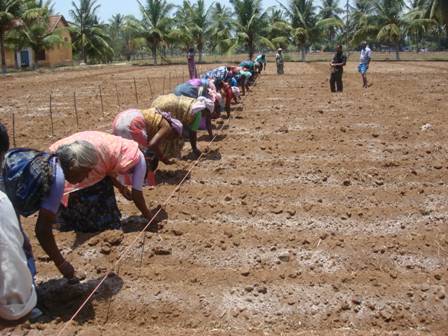
Dibble the seeds at a depth of 3-5 cm

Seedling emergence under flood irrigation system
Source: www.cicr.nic.in
6. WEED MANAGEMENT
i) |
Apply Pendimethalin @ 3.3 l/ha three days after sowing, using a hand operated sprayer fitted with deflecting or fan type nozzle. Sufficient moisture should be present in the soil at the time of herbicide application. This will ensure weed free condition upto 40 days. |
ii) |
One hand weeding on 45 DAS will keep weed free environment upto 60 DAS. |
iii) |
Hoe and hand weed between 18th to 20th day of sowing, if herbicide is not applied at the time of sowing. |

One hand weeding on 45 DAS will keep weed free environment upto 60 DAS
7. GAP FILLING
a. Take up gap filling on the 10th day of sowing.
i) In the case of TCHB 213, raise seedlings in polythene bags of size 15 x 10 cm.
ii) Fill the polythene bags with a mixture of FYM and soil in the ratio of 1:3.
iii) Dibble one seed per bag on the same day when sowing is taken up in the field.
iv) Pot water and maintain.
v) On the 10th day of sowing, plant seedlings maintained in the polythene bags, one in each of the gaps in the field by cutting open the polythene bag and planting the seedling along with the soil intact and then pot water.
b. In the case of all other varieties, dibble 3 to 4 seeds in each gap and pot water.
8. THINNING
Thin out the seedlings on the 15th day of sowing. In the case of fertile soils, allow only one seedling per hole, whereas in poor soil allow two seedlings per hole.
9. TOP DRESSING
i) |
Top dress 50% of the recommended dose of N and K on 40 – 45 DAS for varieties. |
ii) |
Top dress 1/3rd of recommended dose of N on 40-45 DAS and the remaining 1/3rd on 60-65th DAS for hybrids. |
10. RECTIFICATION OF RIDGES AND FURROWS
Reform the ridges and furrows after first top dressing in such a way that the plants are on the top of the ridges and well supported by soil.

11. SPRAYING OF NAPTHALENE ACETIC ACID (NAA)
Spray 40 ppm NAA at 60 and 90 days after sowing on the crop to prevent early shedding of buds and squares and to increase the yield.
NOTE: 40 mg of NAA dissolved in one litre of water will give 40 ppm.
12. MANAGEMENT STRATEGIES FOR DELAYED UMMER IRRIGATED COTTON SOWING
KCI 1% spray, twice on 50 and 70 DAS for delayed sowing (first fortnight of March) of summer irrigated cotton in rice-cotton cropping system for Srivilliputhur region.
13. ARRESTING TERMINAL GROWTH
Nip the terminal portion of the main stem as indicated below:
For varieties having less than 160 days duration nip the terminal portion of the main stem beyond the 15th node (75 to 80 DAS) and for varieties and hybrids having more than 160 days duration beyond the 20th node (85 - 90 DAS).
III. WATER MANAGEMENT
Regulate irrigation according to the following growth phases of the crop.
Stages |
No. of
Irrigations |
Days after dibbling seeds |
Light soil |
Heavy soil |
Germination Phase(1-15 days) |
Irrigate for germination |
1 |
Immediately after sowing |
Immediately after sowing |
and establishment |
2 |
Give a life irrigation on |
Give a life irrigation on |
|
|
5th day of sowing to |
5th day of sowing to |
|
|
facilitate the seedlings |
facilitate the seedlings |
|
|
to emerge out |
to emerge out |
Vegetative phase (16-44 days) |
Regulate |
1 |
Irrigate on the 20th or |
Irrigate on the 20th or 21st day |
|
|
21st day of sowing, three |
of sowing, three days after |
|
|
days after hoeing and |
hoeing and weeding |
|
|
Weeding |
|
|
2 |
Irrigate again on |
Irrigate again on |
|
|
the 35th or 36th |
the 40th day of |
|
|
day of sowing |
Sowing |
Flowering phase (45-100days for hybrids and 87 days for varieties) |
Irrigate copiously |
1 |
48th day |
55th day |
|
2 |
60th day |
70th day |
|
3 |
72nd day |
85th day |
|
4 |
84th day |
100th day |
|
5 |
96th day |
** |
** For TCHB 213 and Suvin only.
Maturity phase(beyond 100 days for hybrids and 88 days for varieties) |
|
For all varieties other than Suvin, and TCHB 213 |
Control irriga |
1 |
108th day |
115th day |
tion during |
2 |
120th day |
130th day |
maturity phase |
3 |
130th day |
|
|
4 |
144th day |
|
|
Stop Irrigation after 150th day |
|
For Suvin, TCHB213 |
|
1 |
108th day |
115th day |
|
2 |
120th day |
130th day |
|
3 |
132nd day |
145th day |
|
4 |
144th day |
160th day |
|
5 |
158th day |
... |
Stop irrigation after 160th day |
|
NOTE: i. |
If irrigation is given on climatological approach, Schedule the irrigation at 0.40 and 0.60 IW/CPE ratio during vegetative and reproductive phases respectively. |
ii) |
The irrigation schedule given above is only a guideline and regulate the irrigation |
|
depending upon the prevailing weather condition and receipt of rains. |
iii) |
Adopt alternate furrow or skip furrow irrigation to save irrigation water. |
The features of the methods are furnished below:
Skip furrow irrigation
- Suited to heavy soils like clay and loam
- Alternate furrows should be skipped and may be converted to ridges having a wide bed formation.
- Short term crops like pulses may be raised in wider bed without exclusive irrigation.
- Water saving is 50% when compared to control.
Alternate furrow irrigation
- During any one run of irrigation a particular set of alternate furrows is irrigated.
- The interval of irrigation should be shortened when compared to the conventional furrows.
- During the next run, the left over furrows be irrigated.
- Suited to heavy soils like clay and loam.
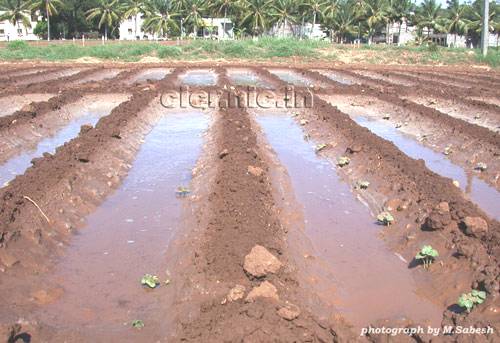
Cotton cultivation under flood irrigation

Cotton cultivation under drip irrigation
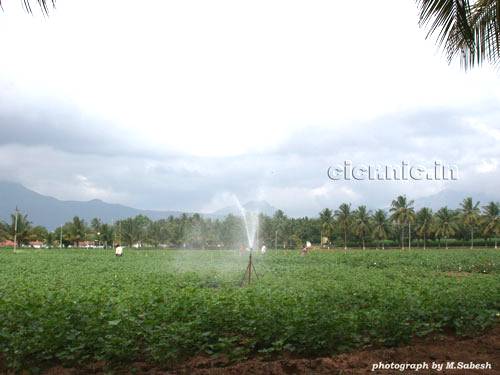
Sprinkler irrigation in cotton
IV. HARVESTING
- Harvest at frequent intervals, at less than 7 days interval.
- Harvest in the morning hours upto 10 to 11 a.m only when there is moisture so that dry leaves and bracts do not stick to the kapas and lower the market value.
- Pick kapas from well burst bolls only.
- Remove only the kapas from the bolls and leave the bracts on the plants.
- After kapas is picked, sort out good puffy ones and keep separately.
- Keep stained, discoloured and insect attacked kapas separately.
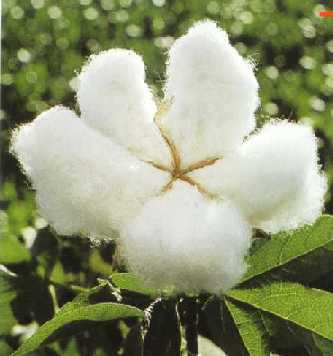
Harvest indices: Well burst boll ready for harvest
NOTE: Do not mix stained, discoloured and insect damaged kapas with good kapas, as they will spoil the good kapas also and lower the market value of the produce.
V. POST HARVEST OPERATIONS |
1) |
Immediately after picking, dry the kapas in shade. If it is not dried immediately the colour will change which will lower the market value. |
2) |
Do not dry the kapas under direct sun as the fibre strength and luster will be lost. |
3) |
Grade the kapas into good and second quality ones, if it is not sorted out at the time of picking. |
4) |
Spread a thin layer of dry sand on the ground and keep the kapas over it. |
RAINFED COTTON
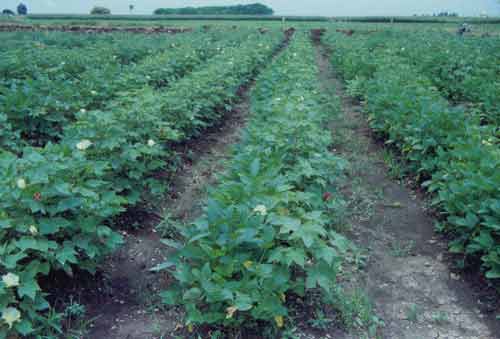
Follow water harvesting techniques and raise a successful crop of cotton.
Season and Varieties
For Thirumangalam in Madurai district, Sattur in Virudhunagar district and parts of Kovilpatti in Thoothukudi district, where the seasonal rainfall is 375 mm and most of it is received during September or first week of October, select LRA 5166 (or) SVPR 2 (or) KC 2.
In places where rains are received during October or November, Select K 11 for Ramanathapuram, Virudhunagar, Tirunelveli and Thoothukudi districts.
PREPARATION OF LAND FOR RAINFED COTTON
1. PREPARATION OF THE FIELD
- Start preparation of the land immediately after harvest of the previous crop.
- Adopt permanent broad ridges system.
2. APPLICATION OF FYM OR COMPOST
i) Spread 12.5 t of FYM or compost or composted coir pith or 2.5t of vermicompost per ha uniformly on the unploughed soil.
ii) Incorporate the manure in the soil by working the multipurpose implement or country plough.
3. APPLICATION OF INORGANIC FERTILIZERS
i) Apply NPK fertilizers as per soil test recommendation as far as possible.
ii) If soil tests are not done, follow the blanket recommendations for the different varieties.
Varieties |
Quantity of fertilizers (Kg/ha) |
|
N |
P2O5 |
K20 |
K 11 |
20 |
0 |
0 |
SVPR 2 |
40 |
20 |
40 |
KC 2 |
40 |
20 |
40 |
4. APPLICATION OF MICRONUTRIENT MIXTURE
i) |
Mix 12.5 kg of micronutrient mixture formulated by the Department of Agriculture, Tamil |
|
Nadu with enough sand to make a total quantity of 50 kg. |
ii) |
Apply uniformly over the furrows after sowing and cover the seeds. |
iii) |
Do not incorporate in the soil. |
5. SEEDS AND SOWING
i) Adopt the following seed rates for different varieties/hybrids.
Varieties |
Quantity of seeds (kg/ha) |
|
Fuzzy seeds |
Delinted seeds |
K11 |
20 |
.. |
LRA 5166, SVPR 2 |
20 |
15 |
Note: Delint only LRA 5166 and SVPR2 seeds. Do not delint seeds of K 9, K10 & K 11
ii) In the case of mixed crop of cotton, maintaining the same seed rates as for a pure crop and adopt the following seed rate for the pulses crop.
Blackgram/greengram 10 kg/ha
Cowpea 7.5 kg/ha
6. SPACING
i) In the case of pure crop of varieties/hybrids, a spacing of 45 cm between rows and 15 cm between plants may be adopted.
ii) In the case of cotton, intercropped with pulses, one paired row of cotton is alternated with two rows of pulses and the total population of cotton crop is maintained at the same line as that for a pure crop of cotton.
Varieties |
Spacing for cotton crop (cm) |
|
Within Paired row |
Between Paired rows |
Between plants |
K 11, LRA 5166, SVPR 2 |
30 |
60 |
15 |
iii) Adopt a spacing of 30 x 10 cm for the pulse crop in between each paired row of cotton. APK 1 Blackgram is best suited for this situation.
7. ACID DELINTING
Adopt procedure for acid delinting as for an irrigated crop.
8. PRETREATMENT OF ACID DELINTED SEEDS WITH FUNGICIDES
Same as for the irrigated crop.
9. SOWING
i) Use the multipurpose farming implement to sow the seeds and to apply basal fertilizers simultaneously.
ii) Fill the hopper in the implement with the fertilizer mixtures and work the implement.
iii) Engage 3 persons for dropping the seeds, 2 for cotton and one for pulses.
In one operation, placement of fertilizer, sowing of seeds and covering will be completed.
NOTE: Cotton and pulses can be sown at a depth of 5 cm in black cotton soil even before the onset of monsoon rains in dry bed sowing. When light rains are received, the moisture will not penetrate deeper and the seeds will not germinate and die away. Only when good rains are received, the moisture level will be sufficient to penetrate to the level of the seed and facilitate germination and proper establishment.
10. WEED MANAGEMENT
i) Pre-emergence application of Pendimethalin 3.3 l/ha followed by one hand weeding on 40 days after crop emergence. At the time of herbicide application sufficient soil moisture must be there.
ii) If sufficient soil moisture is not available for applying herbicides hand weeding may be given at 10 - 20 days after crop emergence.
11. GAP FILLING
Dibble 3 to 4 seeds in each gap if sufficient moisture is available.
12. THINNING SEEDLINGS
- Allow two seedlings per hole and thin out on 15th day of sowing, adopting proper spacing between plants.
- Thin the pulse crop on the 20th day of sowing, adopting a spacing of 15 cm between plants for cowpea and 10 cm for other pulse crop.
13. FOLIAR FERTILIZATION
Spray 0.5% urea and 1% KCl on the 45th and 65th day of sowing if sufficient moisture is available.
14. INTERCULTIVATION WITH DHANTHULU/BLADE HARROW
Work dhanthulu or blade harrow on the 30th and 45th day of sowing.
RICE FALLOW COTTON
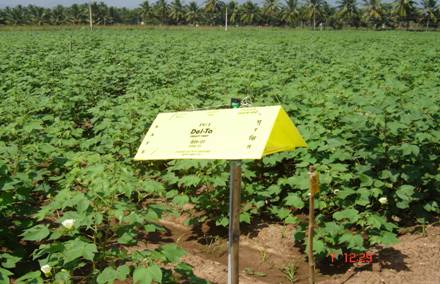
MANAGEMENT OF FIELD OPERATIONS
1. PREPARATION OF THE FIELD
i) If the soil is in waxy condition, instead of Zero tillage, the seed rows may be tilled and the seed dibbled in Virudhunagar district.
ii) If the soil is dry and not in condition to take up sowing, let in water and then allow the soil to dry till soil comes to waxy condition.
iii) At the lower level of the field dig a trench 15 cm wide and connect this trench to the outside channel to drain off the excess water.
2. PRE-TREATMENT OF ACID DELINTED SEEDS WITH FUNGICIDES
i) Same as for the irrigated crop.
ii) Treat the acid delinted and fungicide treated seeds with 3 packets (600g) of Azospirillum and sow immediately.
3. SOWING THE SEEDS
Particulars |
|
|
|
MCU 7 |
SVPR 3 |
a) Seed rate (kg/ha) |
|
|
i) |
Fuzzy seed |
15.0 |
15 |
ii) |
Acid delinted |
7.5 |
7.5 |
b) Spacing (cm) |
|
|
i) |
Between rows |
60 |
60 or 75* |
ii) |
Between plants |
30 |
30 |
c) Number of seeds / hole |
|
|
i) |
Fuzzy seeds |
4 |
4 |
ii) |
Acid delinted |
2 |
2 |
d) Depth of sowing (cm) |
3 |
3 |
* In fertile soils
4. FILLING UP GAPS
i) |
Fill up gaps on the 10th day of sowing. |
ii) |
Dibble 2 to 3 acid delinted seeds or 4 to 5 fuzzy seeds in the gaps in the case of MCU 7 and SVPR 3 |
5. THINNING SEEDLINGS
i) Thin out seedlings on the 20th day of sowing
ii) Leave only one healthy and vigorous seedling per hill.
6. WEED MANAGEMENT
i) Pre-emergence application of Pendimethalin 3.3 l/ha ensures weed free condition for 40 - 45 days. This should be followed by one hand weeding and earthing up during 40 - 45 days.
ii) Take up hoeing and weeding 20 days after sowing.
iii) Take up this operation when the top soil dries up and comes to proper condition.
7. APPLICATION OF FERTILIZERS
- Apply NPK fertilisers as per soil test recommendations. If soil test is not done follow the blanket recommendation of 60:30:30 kg NPK/ha.
- Apply half the dose of N and K full dose of P5O5 at 35th day in old delta and balance in 55 days the rows of cotton plants. In the case New delta apply full P and 1/3 of N and K at 20 DAS and 2/3 N and K at 40 DAS.
8. APPLICATION OF MICRONUTRIENTS
Apply basally12.5 kg/ha micronutrient mixture prepared by Department of Agriculture. Apply MgSo4 basally @ 20 kg/ha to prevent reddening.
9. FORMATION OF RIDGES
Old delta
- If soil is in condition, give a hoeing with mammutti and form ridges and incorporate the fertilizer in the soil around the plants between 30th to 35th day of sowing.
- If soil is not in condition, give one hoeing and weeding and cover the fertilizers.
- Form long ridges and furrows from one end of the field to the other without forming any separate channels for carrying water to prevent excessive soaking of water.
- Form ridges and furrows on alternate rows of plants. Skip furrow method of irrigation to prevent excessive irrigation
New delta
- Give a hoeing with mummutti / spade and form ridges and incorporate the fertilizer in the soil around the plants on the 40th day of sowing.
- If soil is not in condition give one hoeing and weeding and cover the fertilizers.
- Form long ridges & furrows on alternate rows of plants to adopt skip furrow irrigation.
Note: In case of zinc deficient soils, apply 50 kg ZnSo4 /ha
10. APPLYING OF NAA
Spray 40 ppm of NAA (40 mg of NAA dissolved in one litre of water) at 40/45th day using high volume spray. Repeat the same dose after 15 days of first spraying.
11. TOPPING
Arrest terminal growth by nipping the terminal 15th node for controlling excessive vegetative growth. (70-75 DAS)
12. WATER MANAGEMENT
Regulate irrigation according to the growth phases of the crops.
Stages |
No. of |
Days after dibbling seeds |
|
Irriga |
|
|
|
tions |
Old delta |
New delta |
1. Vegetative Phase |
|
|
|
Regulate irrigation |
1 |
One wetting on the 30th |
One irrigation on the 20th day |
during the germination |
|
to 35th day of sowing after |
after the application of fertilisers |
phase |
|
the application of fertilisers |
|
|
2 |
... |
One irrigation on the 40th day |
|
|
|
after the application of N |
2. Flowering Phase |
|
|
|
Irrigate more frequently 1 |
45th day of sowing after the |
45th day |
|
|
application of 2nd dose of N |
|
|
2 |
55th day |
51st day |
|
3 |
65th day |
56th day |
|
4 |
75th day |
61st day |
|
5 |
85th day |
66th day |
|
6 |
... |
71st day |
|
7 |
... |
76th day |
|
8 |
... |
81st day |
|
9 |
... |
86th day |
|
10 |
... |
91st day |
3. Control |
1 |
99th day |
98th day |
Irrigation during |
2 |
113th day |
105th day |
maturity phase |
3 |
... |
112th day |
Stop irrigation from the 113th day onwards.
Note: 1) The irrigation schedule given above is only a guideline and regulate irrigation depending upon the prevailing weather conditions and receipt of rains.
2) Observe the crop and if the plants show wilting symptoms in the afternoon and in the evening hours, give an additional irrigation.
13. Harvesting |
14. Post harvest operation | As that of the irrigated cotton.
15. Pest and disease management |
Source:
www.cicr.nic.in
www.geocities.com/civilwarstudy101/cotton |
|
|















